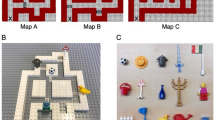Abstract
Maps are indispensable for helping people learn about unfamiliar environments and plan trips. While tactile (2D) and 3D maps offer non-visual map access to people who are blind or visually impaired (BVI), this access is greatly enhanced by adding interactivity to the maps: when the user points at a feature of interest on the map, the name and other information about the feature is read aloud in audio. We explore how the use of an interactive 3D map of a playground, containing over seventy play structures and other features, affects spatial learning and cognition. Specifically, we perform experiments in which four blind participants answer questions about the map to evaluate their grasp of three types of spatial knowledge: landmark, route and survey. The results of these experiments demonstrate that participants are able to acquire this knowledge, most of which would be inaccessible without the interactivity of the map.
Access this chapter
Tax calculation will be finalised at checkout
Purchases are for personal use only
Similar content being viewed by others
References
Giudice, N.A.: Navigating without vision: Principles of blind spatial cognition. Edward Elgar Publishing, In Handbook of Behavioral and Cognitive Geography (2018)
Giudice, N.A., Guenther, B.A., Jensen, N.A., Haase, K.N.: Cognitive mapping without vision: comparing wayfinding performance after learning from digital touchscreen-based multimodal maps vs. embossed tactile overlays. Front. Hum. Neurosci. 14, 87 (2020). https://doi.org/10.3389/fnhum.2020.00087
Biggs, B., Coughlan, J.M., Coppin, P.: Design and evaluation of an audio game-inspired auditory map interface. In: 25th International Conference on Auditory Display (ICAD 2019). Northumbria University, Newcastle-upon-Tyne, UK (June 2019)
Biggs, B.: Designing accessible nonvisual maps. OCAD University (2019) Retrieved from http://openresearch.ocadu.ca/id/eprint/2606
Biggs, B., Pitcher-Cooper, C., Coughlan, J.M.: Getting in touch with tactile map automated production: evaluating impact and areas for improvement. J. Technol. Persons with Disabilities 10 (2022)
Holloway, L., Marriott, K., Butler, M.: Accessible maps for the blind: comparing 3D printed models with tactile graphics. In: Proceedings of the 2018 CHI conference on human factors in computing systems, pp. 1–13 (April 2018)
Shi, L., McLachlan, R., Zhao, Y., Azenkot, S.: Magic touch: interacting with 3D printed graphics. In: Proceedings of the 18th International ACM SIGACCESS Conference on Computers and Accessibility, pp. 329–330 (Oct 2016)
Coughlan, J.M., Shen, H., Biggs, B.: Towards accessible audio labeling of 3D objects. J. Technol. Persons with Disabilities 8 (2020)
Brock, A.M., Truillet, P., Oriola, B., Picard, D., Jouffrais, C.: Interactivity improves usability of geographic maps for visually impaired people. Human-Computer Interact 30(2), 156–194 (2015)
Biggs, B., Coughlan, J.M., Coppin, P.: Design and evaluation of an interactive 3D map. Rehabilit. Eng. Assistive Technol. Soc. North America (2021)
Siegel, A.W., White, S.H.: The development of spatial representations of large-scale environments. Adv. Child Dev. Behav. 10, 9–55 (1975)
Brooke, J.: SUS: a retrospective. J. Usability Stud. 8(2), 29–40 (2013)
Howell, D.C.: Statistical methods for psychology. Cengage Learning (2012)
Coughlan, J.M., Biggs, B., Rivière, M.-A., Shen, H.: An audio-based 3D spatial guidance AR system for blind users. In: 17th International Conference on Computers Helping People with Special Needs (ICCHP ‘20) (Sept 2020)
Acknowledgments
The authors gratefully acknowledge support from NIH grant 5R01EY025332 and NIDILRR grant 90RE5024–01-00. We would like to thank the Magical Bridge Foundation for funding the development of the 3D-printed map.
Author information
Authors and Affiliations
Corresponding author
Editor information
Editors and Affiliations
Rights and permissions
Copyright information
© 2022 Springer Nature Switzerland AG
About this paper
Cite this paper
Coughlan, J.M., Biggs, B., Shen, H. (2022). Non-visual Access to an Interactive 3D Map. In: Miesenberger, K., Kouroupetroglou, G., Mavrou, K., Manduchi, R., Covarrubias Rodriguez, M., Penáz, P. (eds) Computers Helping People with Special Needs. ICCHP-AAATE 2022. Lecture Notes in Computer Science, vol 13341. Springer, Cham. https://doi.org/10.1007/978-3-031-08648-9_29
Download citation
DOI: https://doi.org/10.1007/978-3-031-08648-9_29
Published:
Publisher Name: Springer, Cham
Print ISBN: 978-3-031-08647-2
Online ISBN: 978-3-031-08648-9
eBook Packages: Computer ScienceComputer Science (R0)




